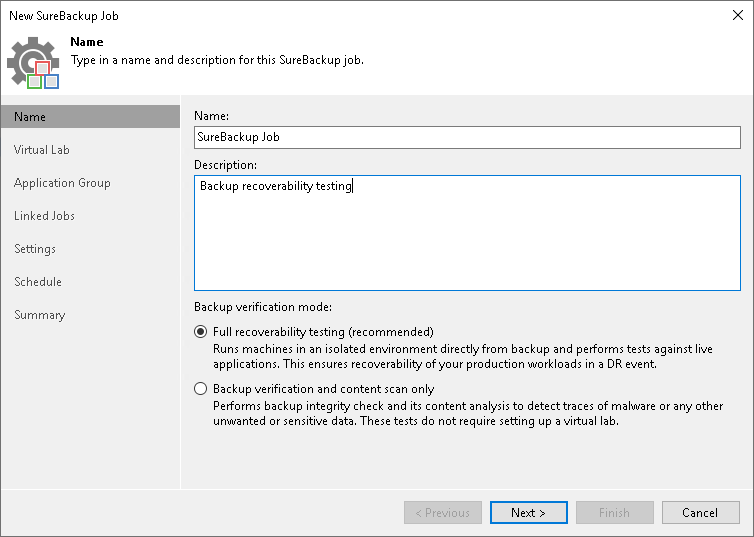Recovery Verification for Veeam Agent Backups
Veeam Backup & Replication offers the SureBackup technology to test backups and check if you can recover data from them. You can verify any restore point of a backed-up computer protected with Veeam Agent for Microsoft Windows and Veeam Agent for Linux.
To learn more about the logic behind SureBackup, see How SureBackup Works.
Before creating the SureBackup job, check limitations for Veeam Agent backups below. Then learn how to prepare your backup infrastructure and create a SureBackup job in Using SureBackup Job.
General Limitations
For backups created with Veeam Agent, SureBackup has the following limitations:
- SureBackup is not supported for backup files created by backup copy jobs.
- SureBackup is not supported for backups stored in the Veeam Cloud Connect repository.
- SureBackup is not supported for backups stored in the archive tier of the the scale-out backup repository.
- For backups created with Veeam Agents, you cannot exclude objects from the scope of the SureBackup job at the Linked Jobs step of the New SureBackup Job wizard.
- [For full recoverability testing mode] SureBackup is not supported for backups containing drives greater than 64 TB.
- [For full recoverability testing mode] If you plan to verify computer recovery with VMware vSphere, consider the following:
- SureBackup is not supported for backups of 4 KB sector drives.
- SureBackup is not supported for backups of storage spaces.
- SureBackup is not supported for backups containing more than 54 drives.
- [For full recoverability testing mode] When Veeam Backup & Replication publishes virtual machines based on backed-up Veeam Agent computers in the isolated virtual environment, all these virtual machines are included in the first isolated network added during the virtual lab configuration. To learn more, see Create Isolated Networks.
Limitations for Backups Created with Veeam Agent for Microsoft Windows
For backups created with Veeam Agent for Microsoft Windows, SureBackup has the following limitations:
- SureBackup is not supported for failover clusters.
- [For full recoverability testing mode] SureBackup is not supported for file-level backups. You must use entire machine or volume-level backup of the protected computer.
- [For full recoverability testing mode] SureBackup is not supported if the Microsoft Windows system partition and boot partition of the backed-up computer are located on different drives.
Limitations for Backups Created with Veeam Agent for Linux
For backups created with Veeam Agent for Linux, SureBackup has the following limitations:
- [For full recoverability testing mode] You cannot use SureBackup with backup files created with Veeam Agent for Linux on Power.
- The successful recovery verification is not guaranteed for the following Linux distributions:
- Amazon Linux 2
- Amazon Linux 2023
- The successful recovery verification is not guaranteed for backups of Linux-based systems that contain encrypted devices.
- If you want Veeam Backup & Replication to connect the recovered VM to the virtual network, one of the following configuration utilities must be installed on the protected computer:
- Netplan
- NetworkManager
- sysconfig
- systemd-networkd
- ifupdown/ifupdown2
- SureBackup is not supported for file-level backups. You must use volume-level backup of the protected computer. The backup must include the root file system (/) and all partitions specified in the /etc/fstab file.
